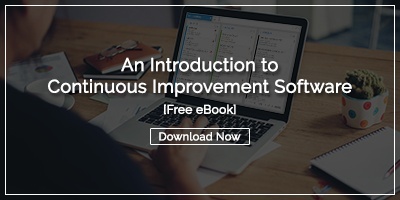 Organizations have adopted the Lean methodology worldwide to improve work processes, reduce waste, and achieve overall performance optimization. The approach grew out of the Toyota production system, which helped Japan capture the automotive market following World War II.
Organizations have adopted the Lean methodology worldwide to improve work processes, reduce waste, and achieve overall performance optimization. The approach grew out of the Toyota production system, which helped Japan capture the automotive market following World War II.
Although there are other popular business management approaches, Lean succeeds because it focuses on improving business processes daily and delivering the end product to customers with the most possible value.
Modern companies leverage Lean management software to ensure that continuous improvement is productive and efficient.
The Principles of Lean Management
The Lean approach rests on five central guiding principles:
1 - Define Value: Value is any aspect of a process or service for which the customer will happily pay. Only the customer can define value. Any process or activity that does not add value is considered waste and should be eliminated if possible or minimized to what is necessary.
2 - Map the Value Stream: To determine what is waste, you must map the flow of value from the initial inputs of raw goods or ideas to delivery to the customer. The value map will make waste apparent.
3 - Create Flow: Once all waste has been eliminated, you can optimize processes to ensure that work flows smoothly through the value chain. To achieve continuous flow, it is essential to solve problems that lead to backlogs and waiting.
4 - Establish Pull: One of the goals of Lean management is to create a just-in-time flow of inventory and work-in-progress throughout the value chain. This means that nothing is purchased or made until it is needed by the next step in the value stream. The concept of Pull eliminates the waste of inventory and helps enhance flow.
5 - Pursue Perfection: Perhaps the most critical Lean idea of all is that of continuous improvement. No matter how well a process operates today, it isn’t perfect. There is always room to implement positive change.![[Watch Now] How to Leverage Lean for Long-Term Success](https://no-cache.hubspot.com/cta/default/326641/eb5ac7b8-b040-48b7-810e-1589561ffff9.png)
Targeting Waste
To make it easier to identify activities and materials that constitute waste, Lean practitioners have established eight categories of waste to consider.
Inventory: Any products, raw materials, or work in progress that is not immediately needed is considered inventory waste. Causes of inventory waste include inefficient processes or suppliers, inaccurate forecasting systems, uneven production processes, and ineffective inventory management and tracking.
Transportation: Unnecessary movement of items or equipment constitutes the waste of transportation. Poor production planning, an inefficient facility layout, and poor scheduling can lead to transport waste.
Motion: Similarly, any unnecessary movement of people is the waste of motion. This waste happens when there is a lack of visual controls, poor process documentation, uncritical workplace layouts, or unhelpful workplace organization.
Over-production: Producing more products or work-in-progress than needed is over-production. Over-production is common when forecasts take the place of just-in-time pull.
Over-processing: Adding features or process steps that don’t add value to the customer is over-processing. Over-processing includes excessive information, redundant approvals and reviews, and unclear customer expectations.
Waiting: The waste of waiting occurs when processes are idle, waiting for inputs that are not prepared in time. Waiting can be caused by long setup times, poor equipment maintenance, inconsistent work methods, or skill deficiencies.
Defects: Defects include the loss of value related to scrap, repair, or rework of a product that does not meet customer requirements. High inventory levels, inadequate equipment or tools, excessive process variation, and transport damage can all lead to quality defects.
Human Potential: The waste of human potential occurs when organizations have unutilized talent and disengaged employees. Human potential is also wasted when employees work in silos and don’t have the opportunity to share their knowledge and skills.
Teams trained to recognize these specific types of waste are better positioned to improve process efficiency and provide a more consistent flow of value.
Lean Management System Software
Choosing to implement technology to support your Lean management efforts is an essential first step to continuous improvement. It’s unlikely that you choose Lean management technology regularly, so it isn’t surprising if you find it a challenge to find the best solution for your organization. Some solutions offered up as Lean management software are nothing more than basic project management tools described in terms of Lean. Instead, the most successful leaders opt for a solution built from the ground up as an improvement management platform.
Systematized Improvement Management: Opportunities for improvement are a core component of Lean management, and capturing them is an essential function of a Lean management system. The platform should make it easy for every employee from the c-suite to the front lines to enter opportunities for improvement whenever they encounter them. The staff should be able to enter new opportunities or work on current projects from the device of their choice, anywhere, at any time.
Digital Huddle Boards: Daily huddles are a staple in many Lean organizations. They often involve team members gathering around a whiteboard or poster that shows the current progress of improvement projects. The best Lean management systems take this concept to the next level by providing fully customizable digital huddle boards that make it easy for staff to participate in huddle meetings from wherever they happen to be. This approach also lets leaders easily manage multiple boards at the same time.
Improvement Scorecards and Reports: Lean is a management practice that is driven by data. Executive leaders and managers should be able to assess the health of their improvement culture by reviewing improvement results and trends. In addition, the Lean platform should provide a visual management interface so that the pace and impact of improvement work can be understood. It should also be easy to identify and recognize the employees, teams, and departments contributing to positive change.
Comprehensive Search: While it may seem like a given, robust search capabilities aren’t present in every software solution that claims to support Lean. With comprehensive search capabilities, your Lean management system can become the home for your organization’s tribal knowledge. Look for a solution that lets you search by topic, status, department, or keyword. Your solution gets bonus points for alerting people to possible duplicates. In addition, you should be able to filter the results to quickly find the information you need at the moment.
Active Alerts and Notifications: One of the main goals of Lean management software is to help keep people involved and engaged in improvement. Alerts and notifications keep everyone informed and help ensure that progress is maintained. But, of course, you want to strike the right balance between useful information and too much noise.
Collaboration Capabilities: Lean management is all about collaboration and cross-functional teamwork. Your Lean management system should make it easy for people to work together even if they are in different locations or functional areas. Status updates, comments, and key performance indicators should help keep everyone on the same page and working toward common goals.
It doesn’t make much sense to choose a system that doesn’t support these core management needs. You don’t have to settle; you can find Lean management technology that does all of this and more. When you do, you’ll put down a strong foundation for success.



Add a Comment